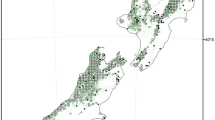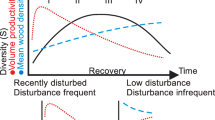Abstract
Modeling and forecasting forests as carbon sinks require that we understand the primary factors affecting productivity. One factor thought to be positively related to stand productivity is the degree of asymmetry, or the slope of the relationship between tree size and biomass growth. Steeper slopes indicate disproportionate productivity of big trees relative to small trees. Theoretically, big trees outcompete smaller trees during favorable growth conditions because they maintain better access to light. For this reason, high productivity forests are expected to have asymmetric growth. However, empirical studies do not consistently support this expectation, and those that do are limited in spatial or temporal scope. Here, we analyze size–growth relationships from 1970 to 2011 across a diverse network of forest sites in the eastern United States (n = 16) to test whether asymmetry is consistently related to productivity. To investigate this relationship, we analyze asymmetry-productivity relationships between our 16 forests at non-overlapping annual, 2-, 5-, 10-, and 20-year sampling intervals and find that asymmetry is negatively related to productivity, but the strength depends on the specific interval considered. Within-site temporal variability in asymmetry and productivity are generally positively correlated over time, except at the 5-year remeasurement interval. Rather than confirming or failing to support a positive relationship between asymmetry and productivity, our findings suggest caution interpreting these metrics since the relationship varies across forest types and temporal scales.






Similar content being viewed by others
References
Alexander MR (2017). Determining the role of stand structure in shaping climate-growth relationships in eastern temperate forests of the US. PhD dissertation, The University of Arizona
Alexander MR, Rollinson CR, Babst F, Trouet V, Moore DJP (2018) Relative influences of multiple sources of uncertainty on cumulative and incremental tree-ring-derived aboveground biomass estimates. Trees 32:265–276. https://doi.org/10.1007/s00468-017-1629-0
Babst F, Bouriaud O, Alexander MR, Trouet V, Frank D (2014) Towards consistent measurements of carbon accumulation: a multi-site assessment of biomass and basal area increment across Europe. Dendrochronologia 32:153–161. https://doi.org/10.1016/j.dendro.2014.01.002
Bakdash JZ, Marusich LR (2017) Repeated measures correlation. Front Psychol 8:456. https://doi.org/10.3389/fpsyg.2017.00456
Bassow SL, Bazzazz FA (1997) Intra- and inter-specific variation in canopy photosynthesis in a mixed deciduous forest. Oecologia 109:507–515. https://doi.org/10.1007/s004420050
Binkley D, Kashian DM, Boyden S, Kaye MW, Bradford JB, Arthur MA, Fornwalt PJ, Ryan MG (2006) Patterns of growth dominance in forests of the Rocky Mountains, USA. For Ecol Manage 236:193–201. https://doi.org/10.1016/j.foreco.2006.09.001
Biondi F (1996) Decadal-scale dynamics at the Gus Pearson natural area: evidence for inverse (a)symmetric competition? Can J For Res 26:1397–1406. https://doi.org/10.1139/x25-156
Bourdier T, Cordonnier T, Kunstler G, Piedallu C, Lagarrigues G, Courbaud B (2016) Tree size inequality reduces forest productivity: an analysis combining inventory data for ten European species and a light competition model. PLos One. https://doi.org/10.1371/journal.pone.0151852
Bowman DMJS, Brienen RJW, Gloor E, Phillips OL, Prior LD (2013) Detecting trends in tree growth: not so simple. Trends Plant Sci 18:11–17. https://doi.org/10.1016/j.tplants.2012.08.005
Braun EL (1950) Deciduous forests of eastern North America. Blakiston Co., Philadelphia
Cahill J (1999) Fertilization effects on interactions between above- and belowground competition in an old field. Ecology 80:466–480. https://doi.org/10.1890/0012-9658(1999)080%5b0466:FEOIBA%5d2.0.CO;2
Canham C, LePage PT, Coates KD (2004) A neighborhood analysis of canopy tree competition: effects of shading versus crowding. Can J For Res 34:778–787. https://doi.org/10.1139/x03-232
Casper BB, Jackson RB (1997) Plant competition underground. Annu Rev Ecol Syst 28:545–570. https://doi.org/10.1146/annurev.ecolsys.28.1.545
Castagneri D, Nola P, Cherubini P, Motta R (2012) Temporal variability of size-growth relationships in a Norway spruce forest: the influence of stand structure, logging, and climate. Can J For Res 42:550–560. https://doi.org/10.1139/x2012-007
Cook E, Briffa K, Shiyatov S, Mazepa V (1990) Tree-ring standardization and growth-trend estimation. In: Cook ER, Kairiukstis LA (eds) Methods of dendrochronology. Springer, Dordrecht, pp 104–110
Coomes DA, Lines ER, Allen RB (2011) Moving on from metabolic scaling theory: hierarchical models of tree growth and asymmetric competition for light. J Ecol 99:748–756. https://doi.org/10.1111/j.1365-2745.2011.01811.x
Craine JM, Dybzinski R (2013) Mechanisms of plant competition for nutrients, water, and light. Funct Ecol 27:833–840. https://doi.org/10.1111/1365-2435.12081
D’Amato AW, Orwig DA, Foster DR (2008) The influence of successional processes and disturbance on the structure of Tsuga canadensis forests. Ecol Appl 18:1182–1199. https://doi.org/10.1890/07-0919.1
Davis SC, Hessl AE, Scott CJ, Adams MB, Thomas RB (2009) Forest carbon sequestration changes in response to timber harvest. For Ecol Manage 258:2101–2109. https://doi.org/10.1016/j.foreco.2009.08.009
del Río M et al (2015) Characterization of the structure, dynamics, and productivity of mixed-species stands: review and perspectives. Eur J For Res 135:23–49. https://doi.org/10.1007/s10342-015-0927-6
DeMalach N, Zaady E, Weiner J, Kadmon R (2016) Size asymmetry of resource competition and the structure of plant communities. J Ecol 104:899–910. https://doi.org/10.1111/1365-2745.12557
Dye A (2018). Annual aboveground biomass growth of temperate forests in eastern North America. PhD Dissertation, West Virginia University
Dye A, Barker Plotkin A, Bishop D, Pederson N, Poulter B, Hessl A (2016) Comparing tree-ring and permanent plot estimates of aboveground net primary productivity in three Eastern US forests. Ecosphere 7:e01454. https://doi.org/10.1002/ecs2.1454
Elkinton JS, Liebhold AW (1990) Population dynamics of gypsy moth in North America. Annu Rev Entomol 35:571–596. https://doi.org/10.1146/annurev.en.35.010190.003035
Foster JR, Finley AO, D’Amato AW, Bradford JB, Banerjee S (2016) Predicting tree biomass growth in the temperate-boreal ecotone: is tree size, age, competition, or climate response more important? Glob Change Biol 22:2138–2151. https://doi.org/10.1111/gcb.13208
Graumlich LJ, Brubaker LB, Grier CC (1989) Long-term trends in forest net primary productivity: Cascade Mountains, Washington. Ecology 70:405–410. https://doi.org/10.2307/1937545
Holmes RL (1983) Computer-assisted quality control in tree-ring dating and measurement. Tree Ring Bull 43:69–78
Jacquart EM, Armentano TV, Spingarn AL (1992) Spatial and temporal tree responses to water stress in an old-growth deciduous forest. Am Midl Nat 127:158–171. https://doi.org/10.2307/2426331
Klesse S, Etzold S, Frank D (2016) Integrating tree-ring and inventory-based measurements of aboveground biomass growth: research opportunities and carbon cycle consequences from a large snow breakage event in the Swiss Alps. Eur J For Res 135(2):1–15. https://doi.org/10.1007/s10342-015-0936-5
Kocin PJ, Uccellini LW (2004) A snowfall impact scale derived from northeast storm snowfall distributions. Bull Am Meteorol Soc. https://doi.org/10.1175/BAMS-85-2-177
Larocque G, Luckai N, Adhikary SN, Groot A, Bell FW, Sharma M (2013) Competition theory—science and application in mixed forest stands: review of experimental and modelling methods and suggestions for future research. Environ Rev 21:71–84. https://doi.org/10.1139/er-2012-0033
Lebourgeois F, Eberle P, Merian P, Seynave I (2014) Social status-mediated tree-ring responses to climate of Abies alba and Fagus sylvatica shift in importance with increasing stand basal area. For Ecol Manag 328:209–218. https://doi.org/10.1016/j.foreco.2014.05.038
Looney CE, D’Amato AW, Fraver S, Palik BJ, Reinikainen MR (2016) Examining the influences of tree-to-tree competition and climate on size-growth relationships in hydric, multi-aged Fraxinus nigra stands. For Ecol Manag 375:238–248. https://doi.org/10.1016/foreco.2016.05.050
Lorimer CG, Frelich LE (1989) A methodology for estimating canopy disturbance frequency and intensity in dense temperate forests. Can J For Res 19:651–663. https://doi.org/10.1139/x89-102
Leuschner C, Hertel D, Coners H, Büttner V (2001) Root competition between beech and oak: a hypothesis. Oecologia 126:276–284. https://doi.org/10.1007/s004420000507
Metsaranta J, Leiffers V (2010) Patterns of inter-annual variation in the size asymmetry of growth in Pinus banksiana. Oecologia 163:737–745. https://doi.org/10.1007/s00442-009-1559-7
Nehrbass-Ahles C, Babst F, Klesse S, Notzli M, Bouriaud O, Neukom R, Dobbertin M, Frank D (2014) The influence of sampling design on tree-ring based quantification of forest growth. Glob Change Biol 20:2867–2885. https://doi.org/10.1111/gcb.12599
Nord-Larsen T, Damgaard C, Weiner J (2006) Quantifying size-asymmetric growth among individual beech trees. Can J For Res 36:418–425. https://doi.org/10.1139/x05-255
Orwig DA, Abrams MD (1997) Variation in radial growth responses to drought among species, site, and canopy strata. Trees 11:474–484. https://doi.org/10.1007/s004680050
Pan Y et al (2011) A large and persistent carbon sink in the world’s forests. Science 333:988–993. https://doi.org/10.1126/science.1201609
Pederson N, Dyer JM, McEwan RW, Hessl AE, Mock CJ, Orwig DA, Rieder HE, Cook BI (2014) The legacy of episodic climatic events in shaping temperate, broadleaf forests. Ecol Monogr 84:599–620. https://doi.org/10.1890/13-1025.1
Pothier D (2017) Relationships between patterns of stand growth dominance and tree competition mode for species of various shade tolerances. For Ecol Manag 406:155–162. https://doi.org/10.1016/j.foreco.2017.09.066
Pretzsch H, Biber P (2010) Size-symmetric versus size-asymmetric competition and growth partitioning among trees in forest stands along an ecological gradient in central Europe. Can J For Res 40:370–384. https://doi.org/10.1139/X09-195
Pretzsch H, Dieler J (2011) The dependency of the size-growth relationship of Norway spruce (Picea abies [L.] Karst.) and European beech (Fagus sylvatica [L.] in forest stands on long-term site conditions, drought events, and ozone stress. Trees 25:355–369. https://doi.org/10.1007/s00468-010-0510-1
Prior LD, Bowman DMJS (2014) Across a macro-ecological gradient forest competition is strongest at the most productive sites. Front Plant Sci 5:260. https://doi.org/10.3389/fpls.2014.00260
Rajaniemi TK (2003) Evidence for size-asymmetry of belowground competition. Basic Appl Ecol 4:239–247. https://doi.org/10.1078/1439-1791-00151
Rewald B, Leuschner C (2009) Belowground competition in a broad-leaved temperate mixed forest: pattern analysis and experiments in a four-species stand. Eur J For Res 128:387–398. https://doi.org/10.1007/s10342-009-0276-4
R Core Team (2018) R: A language and environment for statistical computing. R Foundation for Statistical Computing, Vienna. https://www.R-project.org/
Stokes MA, Smiley TL (1968) An introduction to Tree-Ring Dating. University of Chicago Press, Chicago
Trotsiuk V et al (2016) The legacy of disturbance on individual tree and stand-level aboveground biomass accumulation and stocks in primary Picea abies forests. For Ecol Manag 373:108–115. https://doi.org/10.1016/j.foreco.2016.04.038
Urbano AR, Keeton WS (2017) Carbon dynamics and structural development in recovering secondary forests of the northeastern United States. For Ecol Manag 392:21–35. https://doi.org/10.1016/j.foreco.2017.02.037
Wichmann L (2001) Annual variations in competition symmetry in even-aged Sitka spruce. Ann Bot 88:145–151. https://doi.org/10.1006/anbo.2001.1445
Wiener J (1990) Asymmetric competition in plant populations. Trends Ecol Evol 5:360–364. https://doi.org/10.1016/0169-5347(90)90095-U
Woodbury PB, Smith JE, Heath LS (2007) Carbon sequestration in the US forest sector from 1990 to 2010. For Ecol Manag 241:14–27. https://doi.org/10.1016/j.foreco.2006.12.008
Zang C, Pretzsch H, Rothe A (2011) Size-dependent responses to summer drought in Scots pine, Norway spruce, and common oak. Trees 26:557. https://doi.org/10.1007/s00468-011-0617-z
Zhang J, Huang S, He F (2015) Half-century evidence from western Canada shows forest dynamics are primarily driven by competition followed by climate. Proc Natl Acad Sci USA 112:4009–4014. https://doi.org/10.1073/pnas.1420844112
Acknowledgements
Funding for this work was generously contributed by: National Science Foundation MacroSystems Biology Grant #1241930; the Department of Energy Global Climate Modeling program SC0016011; and the Huron Mountain Wildlife Foundation.
Author information
Authors and Affiliations
Contributions
AD conceived the idea, performed analyses, and wrote the manuscript; AD, MRA, DB, and NP contributed new datasets; DD, NP, and AH helped frame the analysis and contributed intellectual expertise; All Authors provided editorial advice and data interpretation.
Corresponding author
Ethics declarations
Conflict of interest
The authors declare that they have no conflict of interest.
Additional information
Communicated by Christiane Roscher.
Rights and permissions
About this article
Cite this article
Dye, A., Ross Alexander, M., Bishop, D. et al. Size–growth asymmetry is not consistently related to productivity across an eastern US temperate forest network. Oecologia 189, 515–528 (2019). https://doi.org/10.1007/s00442-018-4318-9
Received:
Accepted:
Published:
Issue Date:
DOI: https://doi.org/10.1007/s00442-018-4318-9




